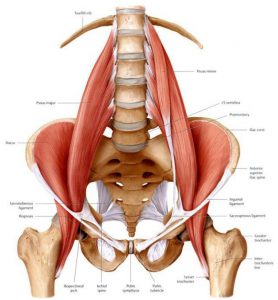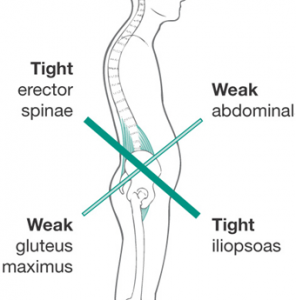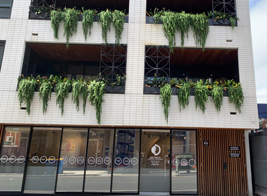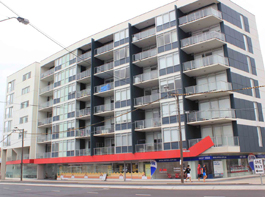HIP FLEXOR TIGHTNESS
The role of the hip flexors:
The hip flexor muscles include the iliacus and psoas major. Together these muscles act to lift the thigh up closer to the abdomen, which is the movement known as hip flexion. Excessive tightness of the hip flexor muscles is more likely to occur in certain people. It can lead to biomechanical abnormalities and be a source of pain.


People that are more prone to hip flexor tightness:
People that have occupations that involve prolonged periods of sitting are prone to hip flexor tightness as the hips are in a sustained flexed position during sitting. People that engage in regular exercise such as running and cycling are also more prone to tight hip flexors. Sportspeople playing kicking sports such as soccer and football are also more likely to experience excessive flexor tightness as the kicking motion involves repetitive hip flexion movements.
The consequences of tight hip flexors:
Tight hip flexors can be a local source of pain around the hip joint which can be present during prolonged periods of sitting or during sporting activities that utilise the hip flexor muscles. Excessive tightness of the hip flexors can change lumbo-pelvic posture as it pulls the pelvis into an anteriorly tilted position. Increased anterior pelvic tilt increases the curve within the lumbar spine (lordosis) which in turn can cause the facet joint of the lumbar spine to be compressed more and tighten up surrounding back extensor muscles such as the erector spinae; this can lead to associated lower back pain.
Tight hip flexors and altered alignment of the pelvis can also lead to over-activity of the hip flexor muscles and altered neuromuscular activity of the gluteal and core muscles which can further be a source of hip pain.
What can we do to reduce hip flexor tightness?
Our experienced physiotherapists at Capital Physiotherapy can help to reduce hip flexor tightness and associated aches and pains through various treatment options which include:
- Massage and trigger point release
- Gluteal and core strengthening to improve lumbo-pelvic stability
- Neuromuscular training
- Stretches
What can you do to reduce hip flexor tightness?
To manage tight hip flexors stretch the hip flexors daily, try and stand up every 30-60 minutes to avoid sitting for prolonged periods.
Drop down into lunge position. Tilt pelvis backwards to activate glutes. Then lean forward at the hips, keeping the back in a neutral position. A stretch should be felt near the groin/front of the thigh. Hold for 30 seconds. Repeat up to 4 times a day. Stretch at least once a day.
If you like this video please LIKE, SUBSCRIBE, SHARE do follow us at Capital Physio Youtube Channel for more weekly updates on health related topics.



 With her wealth of clinical experience – in both public and private systems, Melanie is contactable at Capital Physiotherapy’s Hawthorn Physio clinic to provide you with the best physio treatment in the Hawthorn and for the surrounding suburbs.
With her wealth of clinical experience – in both public and private systems, Melanie is contactable at Capital Physiotherapy’s Hawthorn Physio clinic to provide you with the best physio treatment in the Hawthorn and for the surrounding suburbs.
